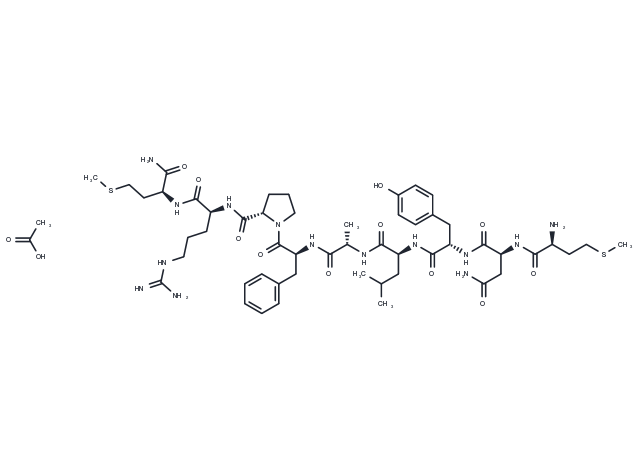keep away from moisture
Powder: -20°C for 3 years | In solvent: -80°C for 1 year

Small Cardioactive Peptide B SCPB acetate (Small Cardioactive Peptide B SCPB acetate (84746-43-0 free base)) is a neurally active peptide, stimulates adenylate cyclase activity in particulate fractions of both heart and gill tissues with EC50s of 0.1 and 1.0 μM, respectively.

| Pack Size | Availability | Price/USD | Quantity |
|---|---|---|---|
| 1 mg | In stock | $ 65.00 | |
| 5 mg | In stock | $ 196.00 | |
| 10 mg | In stock | $ 307.00 | |
| 25 mg | In stock | $ 552.00 | |
| 50 mg | In stock | $ 793.00 | |
| 100 mg | In stock | $ 1,090.00 | |
| 500 mg | In stock | $ 2,220.00 |

| Description | Small Cardioactive Peptide B SCPB acetate (Small Cardioactive Peptide B SCPB acetate (84746-43-0 free base)) is a neurally active peptide, stimulates adenylate cyclase activity in particulate fractions of both heart and gill tissues with EC50s of 0.1 and 1.0 μM, respectively. |
| In vitro | Small cardioactive peptide B (SCPB) is a neurally active peptide endogenous to Aplysia. Small cardioactive peptide B (SCPB) possesses cardioexcitatory effects in Aplysia and reported a threshold concentration of 0.01 nM for both native and synthetic Small cardioactive peptide B (SCPB) stimulated effects on the isolated heart. Effects of Small Cardioactive Peptide B (SCPB) on the physiology of the isolated heart and gill preparations from the mollusc Aplysia californica were examined. In addition, the effects of Small Cardioactive Peptide B (SCPB) and FMRFamide (Phe-Met-Arg-Phe-NH2) on adenylate cyclase activity are compared in particulate fractions of heart and gill tissues, respectively. Small Cardioactive Peptide B (SCPB) is found to exert dose-dependent, reversible changes in cardiac activity when perfused through the isolated heart. The EC50 values effecting changes in heart rate and force of contraction are 0.03 and 0.3 nM, respectively; minimum concentrations find to effect changes in heart rate and force of contraction are normally 0.001 and 1 pM, respectively. When perfused through the isolated gill, Small Cardioactive Peptide B (SCPB) is found to suppress the gill withdrawal response amplitude with a threshold concentration of 0.01 pM and an EC50 value of 0.03 nM. Suppression of the gill withdrawal response amplitude by Small Cardioactive Peptide B (SCPB)is found to be dose dependent and reversible up to a concentration of 1nM. At higher concentrations, the suppression tended to persist irreversibly. Small Cardioactive Peptide B (SCPB) stimulates adenylate cyclase activity in particulate fractions of both heart and gill tissues with an EC50 of 0.1 and 1.0μM, respectively[1]. |
| Synonyms | Small Cardioactive Peptide B SCPB acetate(84746-43-0 free base) |
| Molecular Weight | 1201.47 |
| Formula | C54H84N14O13S2 |
| CAS No. | TP1844L |
keep away from moisture
Powder: -20°C for 3 years | In solvent: -80°C for 1 year
You can also refer to dose conversion for different animals. More
bottom
Please see Inhibitor Handling Instructions for more frequently ask questions. Topics include: how to prepare stock solutions, how to store products, and cautions on cell-based assays & animal experiments, etc.
Small Cardioactive Peptide B SCPB acetate TP1844L Others Small Cardioactive Peptide B SCPB acetate(84746-43-0 free base) Small Cardioactive Peptide B SCPB Acetate inhibitor inhibit
